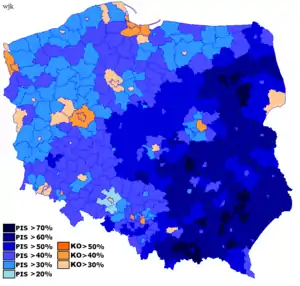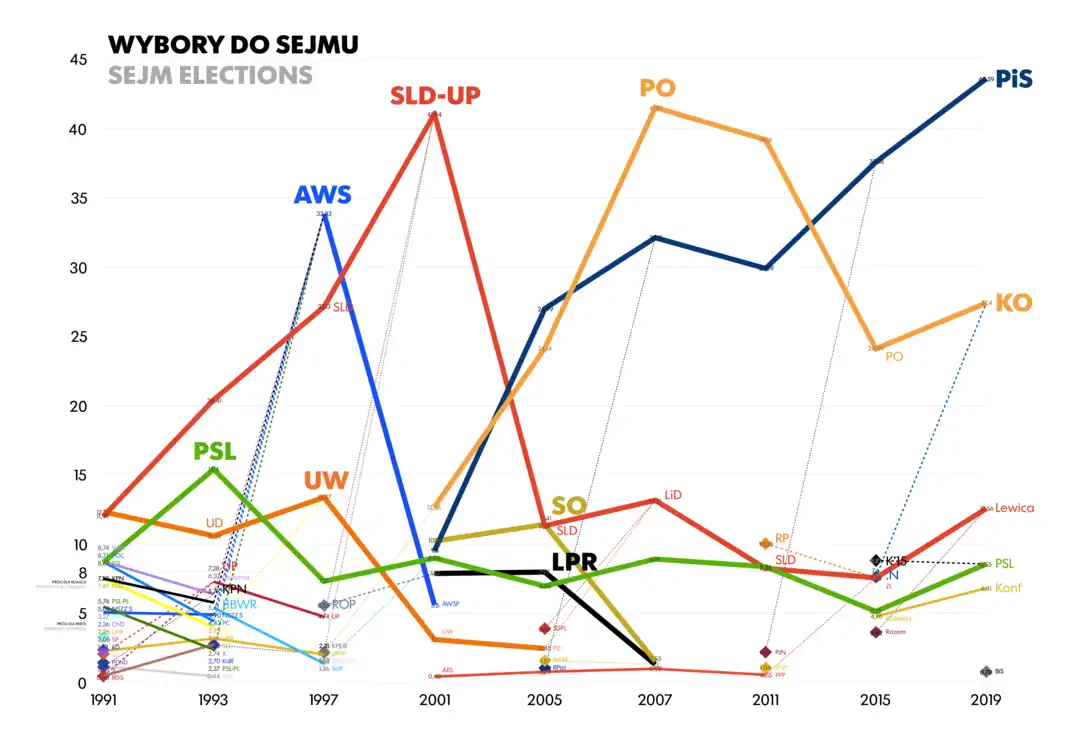2019 Polish parliamentary election
The 2019 Polish parliamentary elections were held on 13 October 2019. All 460 members of the Sejm and 100 senators of the Senate were elected. The ruling Law and Justice (PiS) retained its majority in the Sejm, but lost its majority in the Senate to the opposition. With 43.6% of the popular vote, Law and Justice received the highest vote share by any party since Poland returned to democracy in 1989. The turnout was the highest for a parliamentary election since the first free elections after the fall of communism in 1989.[2] For the first time after 1989, the ruling party controls one house (Sejm) and opposition controls second (Senate).
| |||||||||||||||||||||||||||||||||||||||||||||||||||||||||||||||||||||||||||||||||||||||||||||||||||||
All 460 seats in the Sejm 231 seats are needed for a majority in the Sejm All 100 seats in the Senate of Poland 51 seats are needed for a majority in the Senate | |||||||||||||||||||||||||||||||||||||||||||||||||||||||||||||||||||||||||||||||||||||||||||||||||||||
|---|---|---|---|---|---|---|---|---|---|---|---|---|---|---|---|---|---|---|---|---|---|---|---|---|---|---|---|---|---|---|---|---|---|---|---|---|---|---|---|---|---|---|---|---|---|---|---|---|---|---|---|---|---|---|---|---|---|---|---|---|---|---|---|---|---|---|---|---|---|---|---|---|---|---|---|---|---|---|---|---|---|---|---|---|---|---|---|---|---|---|---|---|---|---|---|---|---|---|---|---|---|
| Opinion polls | |||||||||||||||||||||||||||||||||||||||||||||||||||||||||||||||||||||||||||||||||||||||||||||||||||||
| Registered | 30,253,556 | ||||||||||||||||||||||||||||||||||||||||||||||||||||||||||||||||||||||||||||||||||||||||||||||||||||
| Turnout | 18,678,457 (61.74%) (Sejm) 18,677,930 (61.74%) (Senate) | ||||||||||||||||||||||||||||||||||||||||||||||||||||||||||||||||||||||||||||||||||||||||||||||||||||
| |||||||||||||||||||||||||||||||||||||||||||||||||||||||||||||||||||||||||||||||||||||||||||||||||||||
 Seats won by Sejm district | |||||||||||||||||||||||||||||||||||||||||||||||||||||||||||||||||||||||||||||||||||||||||||||||||||||
| |||||||||||||||||||||||||||||||||||||||||||||||||||||||||||||||||||||||||||||||||||||||||||||||||||||
Background
Following the 2015 parliamentary elections the Law and Justice (PiS) party was able to form a majority government, after receiving 235 seats to the 138 won by their main competitor, Civic Platform, the first time in the post-communist era that a party had won an outright majority in parliamentary elections.[3][4] Beata Szydło became Prime Minister on 16 November 2015 heading a cabinet that also included Solidary Poland and Poland Together, which ran on joint lists with Law & Justice.
On 23 December 2015 the Sejm passed a law, which reorganized the Constitutional Court, introducing a requirement for a two-thirds majority and the mandatory participation of at least 13, instead of 9 of the 15 judges. In addition, in early 2016 the PiS government passed a law which began the process of giving the government full control of state radio and television.[5] In protest, the Committee for the Defence of Democracy, with help from the Modern party and Civic Platform, started demonstrations across the country.[6]
In December 2016 a parliamentary crisis took place, after the Marshal of the Sejm Marek Kuchciński excluded a Civic Platform's MP Michał Szczerba from the Sejm's proceedings.[7] In protest, members of the opposition occupied the Sejm's rostrum. The Marshal, unable to proceed in the main session chamber, moved the session to the smaller Column Hall.[8] Some politicians and comentators supporting Law and Justice accused opposition of attempting a "coup d'état".[9] There was no military involvement in the event. It ended fruitlessly for the opposition, though the Modern party was disgraced, as its leader, Ryszard Petru, was photographed flying to Madeira, with fellow MP Joanna Schmidt, during the tense situation.[10] Modern's opinion poll ratings fell as a result.
In December 2017 Mateusz Morawiecki succeeded Beata Szydło as Prime Minister.[11]
December 6, 2018 the Pro-Polish Coalition was formed[12][13] - an alliance of KORWiN and the National Movement, with more parties joining later in order to contest the 2019 Elections to the European Parliament. The alliance later changed its name to just "Confederation".
In February 2019 the Wiosna party was founded as a left wing anticlerical party.[14] For the 2019 European Parliament elections, the opposition formed a wide coalition, the European Coalition, with the exception of Wiosna. However, PiS won the European elections. Following the loss, the European Coalition dissolved and the Confederation lost many member parties and leaders.[15] In June 2019 Modern and the Civic Platform formed a joint parliamentary club.[16] August 6, the Left was formed, a de facto coalition of Razem, SLD and Wiosna, de jure carrying the SLD name.[17] On August 8, 2019 PSL allied with Kukiz'15 in an alliance named "Polish Coalition".[18]
Electoral system
The 460 members of the Sejm are elected by open party-list proportional representation in 41 multi-member districts. Each district has between 7 and 19 seats.
Seats are allocated using the D'Hondt method, with a 5% threshold for single parties and 8% threshold for coalitions (thresholds are waived for national minorities).
The Senate is elected using first-past-the-post voting in single-member districts.[19] Candidates for Deputies are nominated either by the electoral committees of the various political parties and or by individual voter committees.[20]
Overall, the Sejm includes 460 MPs. Should a party have 231 or more deputies in Parliament, it has an absolute majority and could govern by itself, without a coalition partner.
The constitution can be amended with a supermajority of two-thirds, or 307 deputies.
Election date
The date of the election, 13 October, was set by the President of Poland, Andrzej Duda.
The Constitution of Poland requires that the next election should take place on a non-working day, Sunday or national holiday, within the 30-day period before the expiry of the 4-year period beginning from the commencement of the current Sejm's and Senate's term of office.[21] Elections can be held earlier under certain conditions, for instance, if the Sejm is dissolved or if no government is formed in time limit set by the constitution.[22]
Since the former Sejm and Senate first sitting took place on 12 November 2015,[23] possible dates were Sundays 13 October, 20 October, 27 October, 3 November and 10 November 2019. The other possible but unlikely dates were public holidays 1 November (All Saints' Day) and 11 November (Independence Day) 2019.
Lists
Electoral committees registered in all constituencies
Electoral committees registered in less than half of the constituencies
| List | Ideology | European Union position | Leader | Standing pre-campaign | Number of constituencies | # of candidates | ||||
|---|---|---|---|---|---|---|---|---|---|---|
| Sejm | Senate | Sejm | Senate | |||||||
| 6 | Right Wing of the Republic | Social conservatism, political Catholicism | Soft Euroscepticism | Bogusław Kiernicki | 1 / 460 |
0 / 100 |
0 | 18 | 0 | |
| 7 | Action of Disappointed Retirees and Pensioners | Pensioners' rights, solidarism | Soft Euroscepticism | Wojciech Kornowski | 0 / 460 |
0 / 100 |
3 | 53 | 0 | |
| 8 | Coalition of Nonpartisan and Local Government Activists | Decentralization, pro-single-member districts | Pro-Europeanism | Robert Raczyński | 0 / 460 |
0 / 100 |
19 | 405 | 14 | |
| 9 | Effective | Classical liberalism, direct democracy | Soft Euroscepticism | Piotr Liroy-Marzec | 1 / 460 |
0 / 100 |
5 | 75 | 0 | |
| 10 | German Minority | German minority interests, regionalism | Pro-Europeanism | Ryszard Galla | 1 / 460 |
0 / 100 |
1 | 24 | 2 | |
Electoral committees with candidates only for the Senate
| Name | Ideology | European Union position | Leader | Candidates | ||
|---|---|---|---|---|---|---|
| Sejm | Senate | |||||
| Restore the Law | Pro-single-member districts, populism | Soft Euroscepticism | Janusz Sanocki | Effective list | 7 | |
| Polish Left | Social democracy, third way | Pro-Europeanism | Jacek Zdrojewski | 3 | ||
| List of Mirosław Piotrowski to the Senate | National Catholicism, Christian right | Soft Euroscepticism | Mirosław Piotrowski | 3 | ||
| Self-Defence | Agrarian socialism, left-wing nationalism | Hard Euroscepticism | Lech Kuropatwiński | 2 | ||
| Unity of the Nation | National conservatism, national Catholicism | Soft Euroscepticism | Gabriel Janowski | 2 | ||
| Silesians Together | Localism, Silesian autonomism | Pro-Europeanism | Leon Swaczyna | Polish Coalition list | 2 | |
| List of Kukiz'15 to the Senate | Pro-single-member districts, direct democracy | Pro-Europeanism | Paweł Kukiz | Polish Coalition list | 2 | |
| Other electoral committees with only one candidate | Various | 39 | ||||
Campaign slogans
| List | Slogan in Polish | Unofficial English translation | |
|---|---|---|---|
| Polish Coalition | Łączymy Polaków | We connect Poles | |
| Law and Justice | Dobry czas dla Polski | A good time for Poland | |
| The Left | Łączy nas przyszłość Wybierz przyszłość |
The future unites us Choose the future | |
| Confederation | Polska dla Ciebie | Poland for you | |
| Civic Coalition | Jutro może być lepsze; Współpraca, a nie kłótnie |
Tomorrow can be better; Cooperation, not quarrels | |
| Coalition of Nonpartisans and Local Government Activists | Ty też jesteś bezpartyjny! | You are also nonpartisan! | |
| Effective | Odpowiedzialna Polska | Responsible Poland | |
| German Minority | Opolskie! Ma znaczenie | Opole! It matters | |
Opinion polls

Results
Sejm

 | |||||
| Party | Votes | % | Seats | +/– | |
|---|---|---|---|---|---|
| Law and Justice | 8,051,935 | 43.59 | 235 | –5 | |
| Civic Coalition | 5,060,355 | 27.40 | 134 | –32 | |
| The Left | 2,319,946 | 12.56 | 49 | +49 | |
| Polish Coalition | 1,578,523 | 8.55 | 30 | –28 | |
| Confederation | 1,256,953 | 6.81 | 11 | +7 | |
| Nonpartisan Local Government Activists | 144,773 | 0.78 | 0 | New | |
| German Minority Electoral Committee | 32,094 | 0.17 | 1 | 0 | |
| Effective | 18,918 | 0.10 | 0 | New | |
| Action of Disappointed Retirees and Pensioners | 5,448 | 0.03 | 0 | New | |
| Right Wing of the Republic | 1,765 | 0.01 | 0 | –1 | |
| Total | 18,470,710 | 100.00 | 460 | 0 | |
| Valid votes | 18,470,710 | 98.89 | |||
| Invalid/blank votes | 207,747 | 1.11 | |||
| Total votes | 18,678,457 | 100.00 | |||
| Registered voters/turnout | 30,253,556 | 61.74 | |||
| Source: National Electoral Commission | |||||
By constituency
| Constituency | Turnout | PiS | KO | SLD | PSL | KWiN | MN | Others | Lead |
|---|---|---|---|---|---|---|---|---|---|
| 1 – Legnica | 57.80 | 42.40 | 25.02 | 16.43 | 7.17 | 5.85 | - | 0.00 | 17.38 |
| 2 – Wałbrzych | 55.83 | 40.54 | 32.09 | 12.35 | 7.25 | 5.42 | - | 2.34 | 8.45 |
| 3 – Wrocław | 65.89 | 34.67 | 32.80 | 15.41 | 7.45 | 6.46 | - | 3.21 | 1.87 |
| 4 – Bydgoszcz | 59.90 | 36.43 | 31.05 | 15.17 | 9.02 | 7.05 | - | 1.29 | 5.38 |
| 5 – Toruń | 56.37 | 40.38 | 26.42 | 14.83 | 10.88 | 6.33 | - | 1.16 | 13.96 |
| 6 – Lublin | 60.88 | 55.39 | 19.30 | 7.81 | 9.10 | 7.07 | - | 1.32 | 36.09 |
| 7 – Chełm | 54.40 | 59.50 | 14.80 | 6.83 | 11.86 | 5.84 | - | 1.16 | 44.70 |
| 8 – Zielona Góra | 57.20 | 34.30 | 31.27 | 15.61 | 11.63 | 7.19 | - | 0.00 | 3.03 |
| 9 – Łódź | 68.32 | 32.90 | 35.82 | 20.10 | 4.53 | 6.65 | - | 0.00 | 2.92 |
| 10 – Piotrków Trybunalski | 61.81 | 56.21 | 15.64 | 10.95 | 10.44 | 6.76 | - | 0.00 | 40.57 |
| 11 – Sieradz | 60.92 | 49.81 | 20.48 | 11.98 | 10.29 | 5.88 | - | 1.56 | 29.33 |
| 12 – Kraków I | 62.86 | 53.48 | 23.04 | 8.51 | 7.90 | 7.06 | - | 0.00 | 30.44 |
| 13 – Kraków II | 68.57 | 39.56 | 30.48 | 13.01 | 7.27 | 7.99 | - | 1.69 | 9.08 |
| 14 – Nowy Sącz | 60.28 | 65.80 | 13.83 | 6.07 | 7.35 | 6.95 | - | 0.00 | 51.97 |
| 15 – Tarnów | 60.47 | 59.59 | 14.00 | 5.94 | 13.35 | 7.11 | - | 0.00 | 45.59 |
| 16 – Płock | 57.68 | 52.45 | 16.85 | 8.76 | 15.17 | 5.24 | - | 1.53 | 35.60 |
| 17 – Radom | 60.84 | 57.82 | 17.15 | 7.43 | 10.20 | 5.89 | - | 1.51 | 40.67 |
| 18 – Siedlce | 60.98 | 59.76 | 13.94 | 6.45 | 11.94 | 6.49 | - | 1.42 | 45.82 |
| 19 – Warsaw I | 79.75 | 27.49 | 42.05 | 18.19 | 4.75 | 7.51 | - | 0.00 | 14.56 |
| 20 – Warsaw II | 70.56 | 40.89 | 28.61 | 13.09 | 8.60 | 6.63 | - | 2.19 | 12.28 |
| 21 – Opole | 52.91 | 37.64 | 26.71 | 11.74 | 10.31 | 5.70 | 7.90 | 0.00 | 10.93 |
| 22 – Krosno | 56.37 | 63.36 | 15.94 | 6.04 | 7.85 | 6.81 | - | 0.00 | 47.42 |
| 23 – Rzeszów | 60.13 | 62.38 | 14.39 | 6.59 | 7.79 | 8.25 | - | 0.60 | 47.99 |
| 24 – Białystok | 56.97 | 52.04 | 21.04 | 9.09 | 9.33 | 6.96 | - | 1.55 | 31.00 |
| 25 – Gdańsk | 64.21 | 32.10 | 41.31 | 13.47 | 5.90 | 7.21 | - | 0.00 | 9.21 |
| 26 – Słupsk | 62.79 | 36.43 | 35.85 | 12.47 | 7.94 | 7.30 | - | 0.00 | 0.58 |
| 27 – Bielsko-Biała I | 64.91 | 46.76 | 27.20 | 11.48 | 7.13 | 7.42 | - | 0.00 | 19.56 |
| 28 – Częstochowa | 61.22 | 44.28 | 22.63 | 15.59 | 8.68 | 6.07 | - | 2.75 | 21.65 |
| 29 – Katowice I | 59.18 | 37.75 | 32.61 | 13.38 | 5.99 | 7.67 | - | 2.61 | 5.14 |
| 30 – Bielsko-Biała II | 60.41 | 48.28 | 27.71 | 9.68 | 5.64 | 7.17 | - | 1.54 | 20.57 |
| 31 – Katowice II | 64.00 | 39.19 | 37.20 | 11.92 | 4.37 | 7.33 | - | 0.00 | 1.99 |
| 32 – Katowice III | 62.99 | 37.13 | 29.66 | 21.90 | 4.85 | 6.45 | - | 0.00 | 7.47 |
| 33 – Kielce | 57.70 | 55.18 | 16.65 | 9.95 | 9.88 | 5.95 | - | 2.40 | 38.53 |
| 34 – Elbląg | 52.71 | 40.86 | 28.43 | 11.64 | 10.89 | 5.66 | - | 2.52 | 12.43 |
| 35 – Olsztyn | 54.32 | 38.82 | 26.46 | 13.84 | 13.19 | 6.97 | - | 0.71 | 12.36 |
| 36 – Kalisz | 59.67 | 42.48 | 24.72 | 13.43 | 12.80 | 6.57 | - | 0.00 | 17.76 |
| 37 – Konin | 59.08 | 47.29 | 20.48 | 15.04 | 9.81 | 6.74 | - | 0.64 | 26.81 |
| 38 – Piła | 59.11 | 35.64 | 30.60 | 13.28 | 13.86 | 6.62 | - | 0.00 | 5.04 |
| 39 – Poznań | 73.13 | 25.33 | 45.38 | 16.49 | 6.20 | 6.61 | - | 0.00 | 20.05 |
| 40 – Koszalin | 55.46 | 36.83 | 32.31 | 15.44 | 9.43 | 5.98 | - | 0.00 | 4.52 |
| 41 – Szczecin | 59.36 | 35.11 | 35.71 | 15.25 | 7.40 | 6.53 | - | 0.00 | 0.60 |
| Poland | 61.74 | 43.59 | 27.40 | 12.56 | 8.55 | 6.81 | 0.17 | 0.92 | 16.19 |
Senate


 | |||||
| Party | Votes | % | Seats | +/– | |
|---|---|---|---|---|---|
| Law and Justice | 8,110,193 | 44.56 | 48 | –13 | |
| Civic Coalition | 6,490,306 | 35.66 | 43 | +9 | |
| Polish Coalition | 1,041,909 | 5.72 | 3 | +2 | |
| The Left | 415,745 | 2.28 | 2 | +2 | |
| Nonpartisan Local Government Activists | 331,385 | 1.82 | 0 | New | |
| Confederation | 144,124 | 0.79 | 0 | 0 | |
| Polish Left | 94,988 | 0.52 | 0 | New | |
| Restore the Law | 92,006 | 0.51 | 0 | New | |
| Silesians Together | 50,071 | 0.28 | 0 | New | |
| German Minority Electoral Committee | 49,138 | 0.27 | 0 | 0 | |
| Kukiz'15 to the Senate | 46,210 | 0.25 | 0 | 0 | |
| Mirosław Piotrowski to the Senate | 33,967 | 0.19 | 0 | New | |
| Right Wing of the Republic | 21,943 | 0.12 | 0 | New | |
| Unity of the Nation | 18,327 | 0.10 | 0 | New | |
| National Revival of Poland | 13,859 | 0.08 | 0 | 0 | |
| Normal Country | 13,687 | 0.08 | 0 | New | |
| Self-Defence of the Republic of Poland | 13,510 | 0.07 | 0 | 0 | |
| Labour Party | 11,532 | 0.06 | 0 | 0 | |
| Slavic Union | 8,469 | 0.05 | 0 | 0 | |
| Independents | 1,199,979 | 6.59 | 4 | 0 | |
| Total | 18,201,348 | 100.00 | 100 | 0 | |
| Valid votes | 18,201,348 | 97.45 | |||
| Invalid/blank votes | 476,582 | 2.55 | |||
| Total votes | 18,677,930 | 100.00 | |||
| Registered voters/turnout | 30,253,556 | 61.74 | |||
| Source: National Electoral Commission | |||||

Notes
- Result of Civic Platform and Modern
- Result of United Left and Together
- While a formal political alliance, participants stand for election on the Polish People's Party political party electoral committee lists. Other participants of the political alliance include Kukiz'15, Union of European Democrats, Alliance of Democrats and other associations
- Officially registered as a political party, but is, in fact, a political alliance between KORWiN, National Movement, Confederation of Polish Crown, Union of Christian Families.
- Result of PSL and Kukiz'15
- Result of KORWiN party and God Bless You!, below the 5% threshold.
- The German Minority Electoral Committee only stands in the Opole constituency and as an ethnic minority electoral committee, they are not required to reach the minimum thresholds to send members to the Sejm
- Informally as the United Right with participants standing for election on the Law and Justice political party electoral committee lists. Other participants of the political alliance include Agreement, United Poland, Republican Party, "Piast" Party, and Free and Solidary
- Mateusz Morawiecki was selected as the United Right candidate for Prime Minister of Poland
- While a formal political alliance, participants stand for election on the Democratic Left Alliance political party electoral committee lists. Other participants of the political alliance include Spring, Together and Polish Socialist Party.
- An official coalition electoral committee composed of Civic Platform, Modern, Polish Initiative, and the Greens with candidates from other parties (e.g. Silesian Autonomy Movement), independents, local government activists, and political associations. The threshold of 8% of the votes, therefore, applies.
Further reading
- Radoslaw Markowski (2020) Plurality support for democratic decay: the 2019 Polish parliamentary election, West European Politics.
References
- https://www.tvn24.pl/tvn24-news-in-english,157,m/malgorzata-kidawa-blonska-is-civic-coalition-candidate-for-prime-minister,966541.html
- "Poland celebrates record voter turnout since 1989 elections". TVN24. Retrieved 18 October 2019.
- "Poland Ousts Government as Law & Justice Gains Historic Majority". Bloomberg. 25 October 2015. Retrieved 25 October 2015.
- "Poland elections: Conservatives secure decisive win". 25 October 2015. Retrieved 25 October 2015.
- "Poland's president signs media law despite EU concerns". Business Insider. Retrieved 2016-01-30.
- "Polish media laws: Nationwide protests are staged - BBC News". BBC News. Retrieved 2016-01-30.
- "Poseł Michał Szczerba wykluczony z obrad".
- "Kryzys sejmowy (http://www.tvn24.pl)".
- "Rok temu doszło do próby "puczu" w Polsce. Zapoczątkowało ją prowokacyjne wystąpienie posła Szczerby w Sejmie". wpolityce.pl. Retrieved 2019-10-13.
- "Skruszona Schmidt o locie z Petru: żałuję, to mój błąd". fakt.pl. 2017-02-03. Retrieved 2019-10-13.
- "Dymisja Beaty Szydło przyjęta. Prezydent desygnował nowego premiera". TVN24.pl. Retrieved 2019-10-13.
- Redakcja (2019-02-27). "Konfederacja KORWiN, Liroy, Braun, Narodowcy. Zaprezentowano nazwę i logo. Znamy szczegóły". Polska Times (in Polish). Retrieved 2019-10-21.
- ""Łączy nas Polexit". Narodowcy i Korwin-Mikke łączą siły przed wyborami do PE". Do Rzeczy (in Polish). 2018-12-06. Retrieved 2019-10-13.
- "Robert Biedroń zakłada partię Wiosna. Przedstawiono postulaty". rp.pl (in Polish). Retrieved 2019-10-13.
- "Kaja Godek opuszcza Konfederację. Mówi o "marginalizowaniu pro-liferów"". Pch24.pl (in Polish). Retrieved 2019-10-13.
- Bogdańska, Katarzyna (2019-06-08). "PO i Nowoczesna. Jest decyzja o wspólnym klubie". wiadomosci.wp.pl (in Polish). Retrieved 2019-10-13.
- "Sojusz Lewicy Demokratycznej zmienił skrót z SLD na Lewica | Polska Agencja Prasowa SA". pap.pl. Retrieved 2019-10-13.
- "Oficjalnie: PSL i Kukiz'15 wystartują wspólnie". rp.pl (in Polish). Retrieved 2019-10-13.
- Álvarez-Rivera, Manuel (17 October 2015). "Election Resources on the Internet: Elections to the Polish Sejm, Part I". electionresources.org. Retrieved 25 October 2015.
- http://www.sejm.gov.pl/english/sejm/pos.htm
- Constitution of Poland, Article 98, p. 2.
- Constitution of Poland, Article 98, p. 5.
- "12 listopada odbędą się pierwsze posiedzenia Sejmu i Senatu nowych kadencji". TVP. 5 November 2015. Retrieved 5 November 2015.
- "Poland votes: PiS and its pact with the people".
.jpg.webp)



